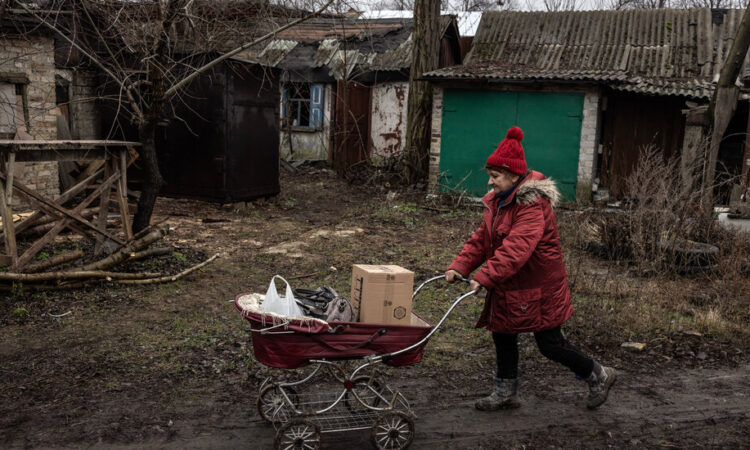
Ukrainian officials were quick to thank the European Union Thursday for approving an assistance package of about $54 billion, funds that will help alleviate a potentially severe financial crisis.
The money will cover pensions, payments to people displaced by war and routine outlays such as salaries for teachers and doctors.
But in thanking his European neighbors, Ukraine’s president, Volodymyr Zelensky, also alluded to uncertainty over future American support, which Ukraine also needs. A $60 billion aid package for Ukraine is currently languishing in the United States Congress.
Europe’s commitment, Mr. Zelensky said, would “send a signal across the Atlantic.”
“Europe sets the tone for global affairs,” he told the E.U. leaders in a video address. “The E.U. has proven that its word matters.”
Ukraine relies on foreign financial aid for about half of its national budget and on foreign military assistance for a majority of the ammunition and weaponry for its full-scale war against Russia, now approaching the end of its second year.
The European assistance, which will be spread out over four years as grants and loans, will prop up the nonmilitary portion of Ukraine’s budget. The E.U. funds cannot be allocated for weaponry or soldiers’ salaries. Ukraine relied on its own tax revenues to fund military salaries and some purchases of weapons and ammunition.
Since the start of the war, the European Union as an organization and E.U. countries individually have made available 43.3 billion euros, or about $47 billion, in support for Ukraine. It includes emergency assistance, crisis response, humanitarian aid and general budget support.
Europe has also provided around €28 billion worth of military assistance, of which around €6 billion came from the joint E.U. budget.
Ukraine had risked a crippling financial crisis if the aid were not forthcoming, the country’s finance minister, Serhiy Marchenko, said in a recent interview.
Before the E.U. announcement on Thursday, the government had been considering cuts in spending that could have stirred instability or driven more Ukrainians into Europe as refugees. These had included canceling a planned indexing of pensions to inflation, which could have pushed tens of thousands of older people below substance income levels.
Without the aid, Ukraine would have been compelled to issue bonds at sky-high interest rates, risking a spiral of unsustainable debt. And the aid reduces the likelihood Ukraine will be forced to print money to finance the budget, risking hyperinflation that would unnerve the country already facing military setbacks.
Still, the absence of funds from the United States is problematic. The first E.U. tranche of $4.5 billion euros is expected in March.
In Washington, Republicans in Congress have held up a vote on a supplemental spending bill with aid for Ukraine and Israel, seeking to pair it with increased funding for border security. But the prospects for passage grew dimmer late last month when former President Donald J. Trump pressed Republicans to hold out for tougher measures.
Without American assistance — about $11 billion of $60 billion in the U.S. package is planned as financial support, the remainder for weaponry and humanitarian aid — the road becomes much tougher, Ukrainian officials and analysts have said. International Monetary Fund lending that supports Ukraine’s Central Bank in maintaining a stable exchange rate is contingent on the United States approving assistance.
The Central Bank has been spending down its reserves of about $40 billion to prop up the national currency, the hryvnia, which plunged in value in the months after the invasion before stabilizing. A currency devaluation could trigger runs on banks, demoralizing the population already emotionally on edge from war, Ukrainian officials have said.
Ukraine’s foreign minister, Dmytro Kuleba, said in a post on X of the decision that, “Europe has once again demonstrated its strength and ability to make major decisions independent of others.”
He added that, “This is also a clear indication that Putin’s hopes of outlasting Ukraine’s and the world’s resolve are futile.”
Military assistance, which was not included in the E.U. package, is also critical for economic stability. Western-provided air defense systems have this winter mostly shielded Kyiv, the capital, and other cities from missiles targeting infrastructure, preventing disruptive blackouts. With the American support stalled, air defense ammunition is running low, military analysts say.
In the clearest link between military aid and economic gains, cruise missiles provided by Britain and France have targeted Russian warships in conjunction with Ukrainian attacks using exploding sea drones.
The attacks have forced Russia to base its Black Sea fleet farther from Ukraine’s coast. This has allowed regular commercial shipping to resume to Ukrainian ports that handle grain and steel, key export commodities.
Mr. Zelensky’s speech praising the European financial aid was tempered by an element of reproach for delays in sending weaponry.
He said Russia had received artillery shells from North Korea and exploding drones from Iran, while European nations had fallen behind on a promise to deliver one million artillery shells to Ukraine. “This, too, is a signal of global competition, in which Europe cannot afford to lose,” Mr. Zelensky said.
The financial backing from Europe at least checks one box for Ukraine in shoring up assistance from allies that had wavered amid the war.
Ukraine’s ministry of finance issued a statement saying the multiyear package will bring an element of stability to the country’s finances, fund reforms needed to move toward European Union membership and help attract private investment to the economy.
The aid, said Mr. Marchenko, the minister of finance, “is not only about financial assistance, but also about trust in our country as a partner and the European future of our country.”
Marc Santora contributed reporting from Kyiv and Monika Pronczuk from Brussels.






